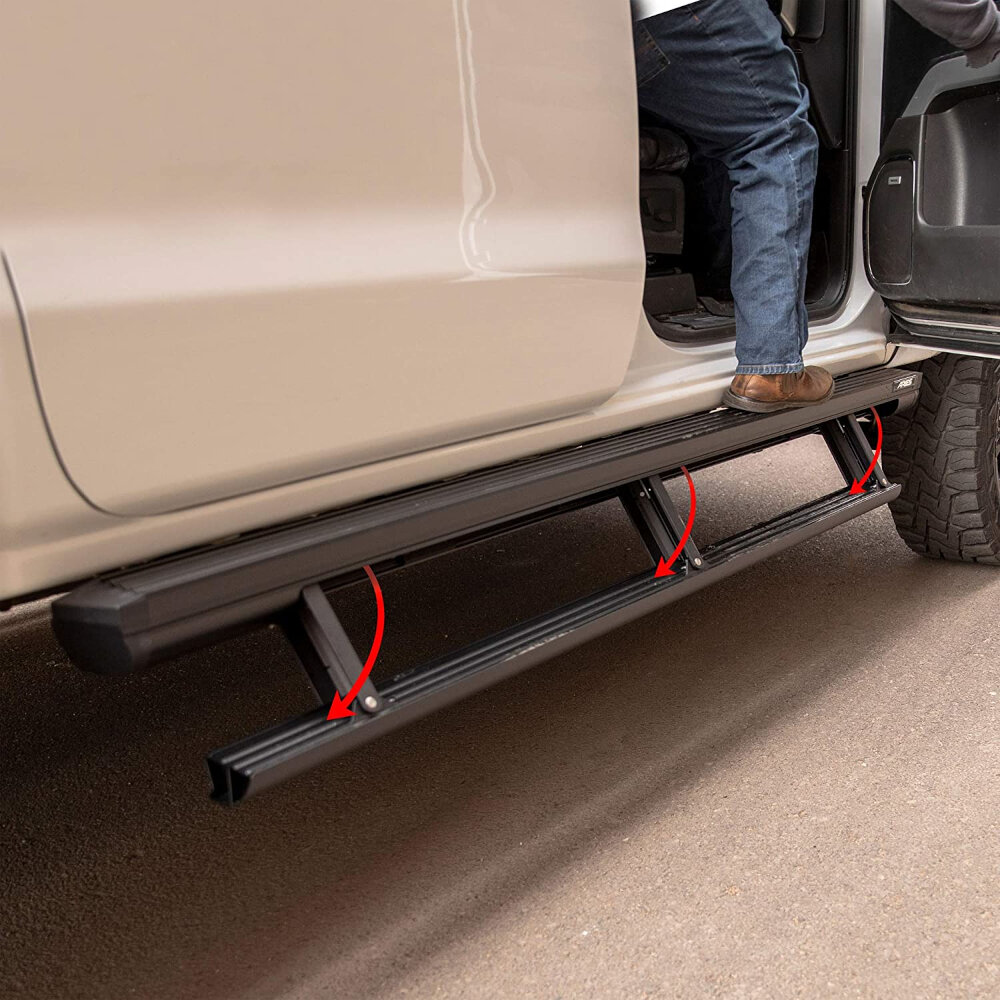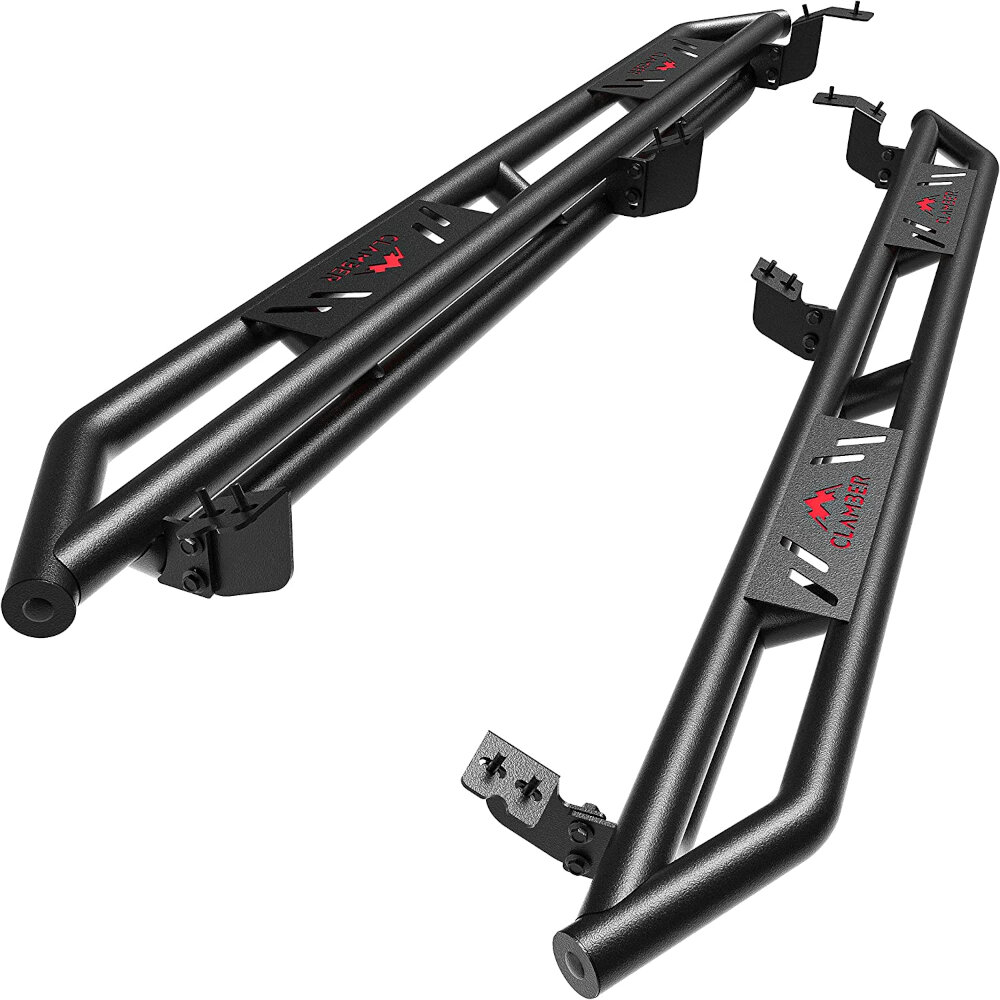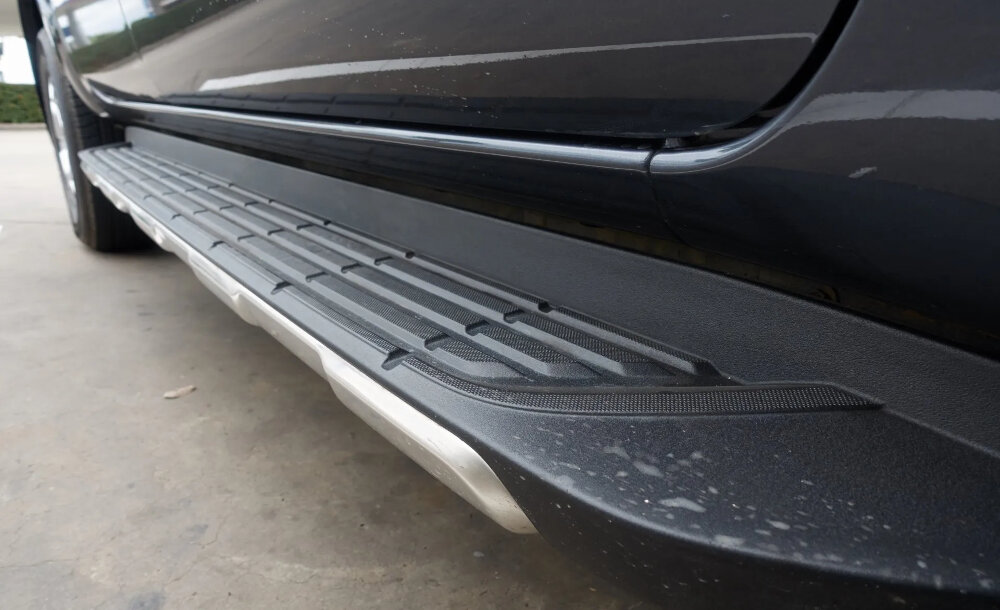Exploring Running Board Materials: What Are They Made Of?

Running boards have become a popular addition to modern vehicles. They provide a practical and stylish solution for easier access to the vehicle and added protection from debris and road hazards. However, not all running boards are created equal, and one of the most critical factors to consider is the material they are made of. Understanding the different materials and their properties can help you make an informed decision when choosing the right running boards for your vehicle. There are several materials used in the manufacturing of running boards, ranging from traditional metals to innovative composites. Each material has its unique set of advantages and disadvantages, including durability, weight, cost, and aesthetics. In this article, we will explore some of the most commonly used materials for running boards, including aluminum, stainless steel, ABS plastic, and fiberglass, to help you make an informed decision when selecting the best option for your vehicle.
Running boards are an essential accessory for vehicles, especially for larger ones, such as trucks, SUVs, and vans. They are horizontal panels that are installed on the sides of a vehicle’s frame, running from the front to the rear wheels. The primary purpose of running boards is to provide a step for passengers to get in and out of the vehicle more easily. They also serve as a protective barrier between the vehicle’s body and road debris, such as rocks and mud. Running boards can be made from various materials, depending on the vehicle’s make and model, as well as the owner’s preference. Popular materials include aluminum, steel, plastic, and fiberglass, each with its advantages and disadvantages. Ultimately, the choice of running board material comes down to the intended use and personal preference.
When it comes to running boards, knowing the materials they are made of is crucial for making informed purchase decisions. Different materials have varying levels of durability, weight, and aesthetic appeal. For instance, aluminum and stainless steel boards are highly durable and can withstand extreme weather conditions, while plastic boards may be lighter and less expensive, but may not last as long. Additionally, some materials may offer better traction, making them safer for use in wet or slippery conditions. In short, understanding the materials used in running boards can help buyers choose products that are not only attractive but also functional and long-lasting.
Aluminum

Aluminum is a lightweight and durable metal that is commonly used in the automotive industry for various components, including running boards. The use of aluminum in running boards offers several benefits, including its corrosion resistance, ability to withstand harsh weather conditions, and its strength-to-weight ratio. Additionally, aluminum is easily shaped and molded to fit specific designs, making it a versatile material for running boards. One of the significant advantages of aluminum running boards is their resistance to rust and corrosion. This is especially important for vehicles that are frequently exposed to moisture, such as those used in coastal areas. Aluminum is also highly durable and can withstand harsh weather conditions, making it an ideal material for running boards. Furthermore, its strength-to-weight ratio is impressive, allowing manufacturers to create lightweight yet sturdy running boards that can support the weight of passengers without adding unnecessary weight to the vehicle. Overall, aluminum is an excellent choice for running board materials, providing a combination of strength, durability, and corrosion resistance.
Aluminum is a popular material used for running boards due to its numerous advantages. One of its main benefits is its lightweight nature, which makes it easy to handle and install. Additionally, it is a very durable material that can withstand harsh weather conditions and resist corrosion. Aluminum is also a highly versatile material that can be easily molded into different shapes and sizes, making it suitable for a wide range of applications. Another advantage of aluminum is its low maintenance requirements, as it does not require frequent cleaning or polishing to maintain its appearance. Finally, aluminum is an environmentally friendly material that can be easily recycled, making it a sustainable option for automotive manufacturing.
Despite its numerous advantages, aluminum also has some notable disadvantages. One of the most significant drawbacks of aluminum is its susceptibility to corrosion, especially in environments with high humidity or salt levels. This can weaken the metal and shorten its lifespan. Additionally, aluminum is a lightweight material, which can be a disadvantage in situations where durability and strength are required. While it is strong enough to support most vehicles, it may not hold up as well as other materials in heavy-duty applications. Finally, aluminum is a relatively expensive material compared to other options, which can make it less appealing for budget-conscious consumers.
Aluminum is a popular material used for running boards due to its durability and lightweight nature. It is a cost-effective solution that can withstand harsh weather conditions and resist corrosion. Aluminum running boards are commonly used in commercial vehicles, trucks, and SUVs, providing a non-slip surface for easy entry and exit. The material can be easily shaped and customized, making it an ideal option for creating unique designs and styles. Moreover, aluminum is a sustainable material that can be recycled, making it an eco-friendly choice for those who prioritize environmental responsibility. Overall, aluminum running boards are a reliable and practical choice that offers both functionality and style.
Steel

Steel is a popular material used for making running boards due to its durability, strength, and resistance to corrosion. Steel is an alloy consisting of iron and carbon, and sometimes other elements such as manganese, chromium, and nickel. The carbon content in steel determines its strength, with higher carbon content resulting in stronger steel. Steel is often coated with a layer of zinc to protect it from rust and corrosion, making it an ideal material for use in harsh environments. Steel running boards are often used in heavy-duty trucks and SUVs, as they can withstand the weight of passengers and cargo without bending or buckling. One of the advantages of steel running boards over other materials is their ability to withstand impacts. Steel is a tough material that can absorb impacts without deforming or breaking. This makes steel running boards an ideal choice for off-road vehicles that may encounter rough terrain or obstacles on the road. However, steel running boards can be heavier than other materials, which can affect fuel efficiency and handling. Additionally, steel can rust if it is not properly protected, so it is important to choose high-quality steel running boards that are coated with a layer of zinc or other anti-corrosion material. Overall, steel is a versatile and durable material that is well-suited for use in running boards for a variety of vehicles.
Steel is a highly versatile material that has a wide range of applications in various industries. One of the most significant advantages of steel is its exceptional strength and durability, which makes it ideal for use in construction and manufacturing. It is also highly resistant to wear and tear, corrosion, and extreme weather conditions, making it an excellent choice for outdoor applications. Additionally, steel is easy to fabricate, weld, and shape, allowing for customization and flexibility in design. It is also an environmentally friendly material that is fully recyclable, making it a sustainable choice for construction and manufacturing. Overall, the advantages of steel make it a popular choice for a wide range of applications, including running boards for vehicles.
While steel is undoubtedly a popular material in the automotive industry, it is not without its disadvantages. One of the main drawbacks of steel is that it is heavy, which can affect the overall weight and fuel efficiency of a vehicle. Additionally, steel is susceptible to corrosion over time, especially when exposed to moisture and salt, which can lead to rust and deterioration. Steel also requires a significant amount of energy and resources to produce, making it less environmentally friendly than other materials. Finally, steel can be difficult and expensive to repair or replace, especially in the case of severe damage or wear and tear. Despite these drawbacks, steel remains a durable and reliable material for running boards and other automotive components.
Steel is a popular material used in the manufacturing of running boards. It is known for its strength, durability, and resistance to corrosion, making it an excellent choice for tough and rugged conditions. Steel running boards are commonly found on trucks and SUVs and are designed to support the weight of passengers as they enter and exit the vehicle. They are also used for added protection against rocks, debris, and other hazards encountered while off-roading. Steel running boards can come in various styles and finishes, such as powder-coated or stainless-steel, providing both functionality and style to the vehicle.
Plastic

Plastic is a synthetic material that has revolutionized the manufacturing industry. It is a versatile material that can be molded into a wide range of shapes and sizes. Plastic is derived from petrochemicals and is a byproduct of the oil refining process. It has a low cost of production, making it an attractive alternative to other materials. The durability and flexibility of plastic make it an ideal material for the manufacturing of running boards. The material can withstand harsh weather conditions, UV radiation, and impact without sustaining any significant damage. Additionally, plastic is lightweight, which makes it easier to install and handle. However, the use of plastic in manufacturing has raised concerns about its environmental impact. Plastic is non-biodegradable and can take hundreds of years to decompose. It is a major contributor to environmental pollution, particularly in marine environments. Plastic waste ends up in oceans and other water bodies, where it poses a significant threat to marine life. Additionally, the manufacturing of plastic produces harmful greenhouse gases that contribute to climate change. Despite its many advantages, the use of plastic in manufacturing should be balanced against its negative environmental impact.
Plastic is a versatile and durable material that has many advantages. First, it is lightweight, which makes it easy to handle and transport. Second, it is resistant to water and chemicals, making it ideal for use in a wide range of applications. Third, plastic is easy to manufacture, which means that it is cost-effective and can be produced in large quantities. Fourth, it is highly customizable and can be molded into a variety of shapes and sizes. Finally, plastic is recyclable, which means that it can be reused instead of ending up in landfills or oceans. These advantages make plastic a popular choice for a variety of products, including running boards for vehicles.
One of the greatest disadvantages of plastic is its impact on the environment. Plastic can take hundreds of years to decompose, and it often ends up in landfills or polluting the oceans. Not only does this harm wildlife and ecosystems, but it also poses a threat to human health as these plastics can break down into microplastics that can enter the food chain. Additionally, the production of plastic requires significant amounts of fossil fuels, contributing to climate change and the depletion of natural resources. Despite its versatility and convenience, the negative consequences of plastic make it a less desirable material choice for running boards.
Plastic is a widely used material in running boards due to its durability, flexibility, and lightweight properties. It is often used as a top layer in running boards to provide a non-slip surface for users. Additionally, plastic is resistant to corrosion and can withstand extreme weather conditions, making it suitable for use in outdoor environments. Plastic is also easy to mold and shape, allowing manufacturers to create intricate designs and patterns on running boards. Furthermore, plastic is an affordable material, making it a popular choice for mass-produced running boards. Overall, plastic is a versatile and practical material that is commonly used in running boards for its functional and aesthetic properties.
Fiberglass

Fiberglass is a popular material used in the manufacturing of running boards. It is composed of woven glass fibers that are embedded in a resin material. The glass fibers provide the strength and durability needed to withstand the weight and pressure of the vehicle, while the resin material provides a smooth and corrosion-resistant surface. Fiberglass is known for its lightweight and high-strength properties, making it an ideal material for running boards. Additionally, fiberglass is easy to shape and can be molded into various designs and sizes, offering a range of possibilities for customization. One of the main benefits of fiberglass running boards is their resistance to harsh weather conditions. They are not affected by extreme temperatures, moisture, or UV rays, making them suitable for use in any climate. Fiberglass is also resistant to corrosion and rust, making it a long-lasting option for running boards. Another advantage of fiberglass is its easy maintenance. It can be easily cleaned with soap and water, and its smooth surface resists dirt and grime buildup, making it an ideal choice for those who want a hassle-free running board. Overall, fiberglass is a versatile, durable, and low-maintenance material that offers a wide range of benefits for running boards.
Fiberglass is a popular material for running boards due to its numerous advantages. Firstly, it is incredibly durable and resistant to wear and tear, making it ideal for vehicles that are frequently used or subject to harsh conditions. It is also lightweight, which can improve fuel efficiency and handling. Additionally, fiberglass can be molded into various shapes and styles, providing designers with a wide range of customization options. It is also weather-resistant, making it suitable for use in all climates. Finally, fiberglass is relatively easy to maintain, requiring minimal cleaning or upkeep to keep it looking great. Overall, fiberglass is an excellent choice for running boards due to its strength, versatility, and durability.
Fiberglass, a popular material for running boards, has its disadvantages. One of the main drawbacks is its susceptibility to cracking and chipping. This can occur due to impact or even just normal wear and tear. Additionally, fiberglass can fade and discolor over time due to exposure to UV rays. This can lead to a less attractive appearance and may require frequent painting or refinishing to maintain its original color. Another disadvantage of fiberglass is that it can be more expensive than other materials, such as aluminum or steel. Despite these drawbacks, fiberglass remains a popular choice for running boards due to its lightweight and durable nature.
Fiberglass is a widely used material in the production of running boards due to its durability, strength, and lightweight properties. It’s a composite material that consists of fine glass fibers and plastic, which is molded into various shapes and sizes. Fiberglass running boards are known for their resistance to corrosion, weathering, and impact, making them ideal for off-road and heavy-duty vehicles. Additionally, fiberglass is easy to customize and can be designed to match the color and style of the vehicle. The material is also relatively affordable compared to other options, making it a popular choice for those looking for a cost-effective solution. Overall, fiberglass running boards offer an excellent balance of strength, flexibility, and aesthetics, making them a top choice for many vehicle owners.
Running boards are an essential accessory for trucks and SUVs, providing a step up into the vehicle. These boards are made from a variety of materials, each with its own strengths and weaknesses. Aluminum is a popular choice for running boards due to its lightweight and corrosion-resistant properties. Stainless steel is another popular choice, known for its durability and resistance to rust. Fiberglass is a lightweight and affordable option, but it may not be as durable as other materials. ABS plastic is a lightweight and inexpensive option that provides good slip resistance, but it may not be as durable as other materials. Ultimately, the choice of material will depend on personal preference, budget, and the intended use of the running boards.
When choosing a running board material, there are several factors to consider. The first is durability, as running boards are often exposed to harsh weather conditions and debris. The material should also be slip-resistant to prevent accidents. Another factor to consider is the weight of the material, as it can affect the vehicle’s performance. Additionally, the appearance of the material should be taken into account as it can enhance the overall look of the vehicle. The cost of the material should also be considered, as some materials are more expensive than others. Ultimately, the choice of running board material will depend on personal preferences, budget, and the intended use of the vehicle.
Conclusion

In conclusion, exploring the materials used in making running boards has provided us with a deeper understanding of their composition, properties, and benefits. From traditional materials like steel and aluminum to newer options like plastic and composite materials, each has its unique advantages and disadvantages. While steel may be the strongest and most durable, it may also be the heaviest and prone to rusting. On the other hand, plastic may be lightweight and corrosion-resistant but may not be as sturdy. Ultimately, the material you choose for your running boards will depend on your specific needs and preferences. By considering factors like functionality, aesthetics, and budget, you can make an informed decision and enjoy the benefits of having the right running board material for your vehicle.

